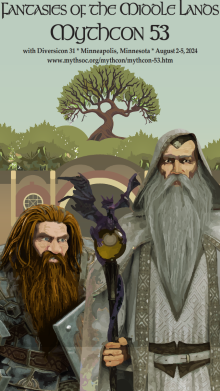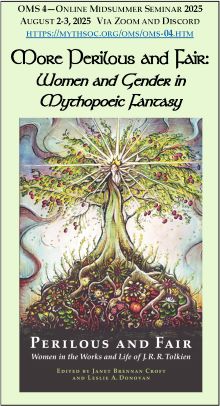Loading...
Location
Minneapolis, Minnesota
Document Type
Presentation
Event Website
https://www.mythsoc.org/mythcon/mythcon-53.htm
Start Date
4-8-2024 2:30 PM
End Date
4-8-2024 3:20 PM
Description
In a review of his friend J.R.R. Tolkien’s The Lord of the Rings, C.S. Lewis characterizes its precursor The Hobbit as “a fragment torn from the author’s huge myth.” Lewis is not speaking simply of Tolkien’s longer work as the larger myth, but the legendarium of Middle-earth. Other literary critics have also praised Tolkien for his creation of a convincing mythology alongside the geography, maps, and history of Middle-earth. The word “myth” continually appears in analyses of Tolkien’s writing, writing that has captivated readers since its conception. It is therefore logical to infer that this mysterious mythic quality holds great significance in the contemporary literary imagination. Similarly, C.S. Lewis is continually calling his own readers into the murky depths of myth, a place he seems to have a great fondness for. His literary masterpiece, Till We Have Faces: A Myth Retold, works philosophy and theology into the compelling story of Cupid and Psyche. In this paper, I argue that mystery is essential to Lewis’s understanding and application of myth, seen both in his nonfiction writings and in his novel Till We Have Faces. First, I will examine Lewis’s response to psychological literary criticism and argue that his dissatisfaction stems from the absence of an appreciation for mystery. Second, I will examine Lewis’s argument for the place of mystery in religion in Till We Have Faces, and argue for its place in myth.
Creative Commons License

This work is licensed under a Creative Commons Attribution-NonCommercial-No Derivative Works 4.0 International License.
Included in
An Inkling of Mystery: Examining C.S. Lewis’s Philosophy of Myth
Minneapolis, Minnesota
In a review of his friend J.R.R. Tolkien’s The Lord of the Rings, C.S. Lewis characterizes its precursor The Hobbit as “a fragment torn from the author’s huge myth.” Lewis is not speaking simply of Tolkien’s longer work as the larger myth, but the legendarium of Middle-earth. Other literary critics have also praised Tolkien for his creation of a convincing mythology alongside the geography, maps, and history of Middle-earth. The word “myth” continually appears in analyses of Tolkien’s writing, writing that has captivated readers since its conception. It is therefore logical to infer that this mysterious mythic quality holds great significance in the contemporary literary imagination. Similarly, C.S. Lewis is continually calling his own readers into the murky depths of myth, a place he seems to have a great fondness for. His literary masterpiece, Till We Have Faces: A Myth Retold, works philosophy and theology into the compelling story of Cupid and Psyche. In this paper, I argue that mystery is essential to Lewis’s understanding and application of myth, seen both in his nonfiction writings and in his novel Till We Have Faces. First, I will examine Lewis’s response to psychological literary criticism and argue that his dissatisfaction stems from the absence of an appreciation for mystery. Second, I will examine Lewis’s argument for the place of mystery in religion in Till We Have Faces, and argue for its place in myth.
https://dc.swosu.edu/mythcon/mc53/schedule/51


